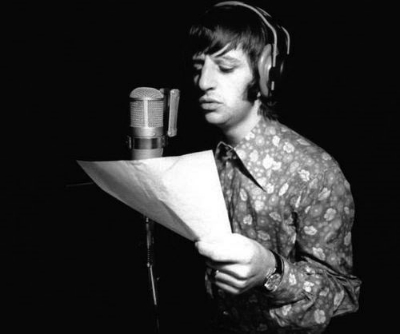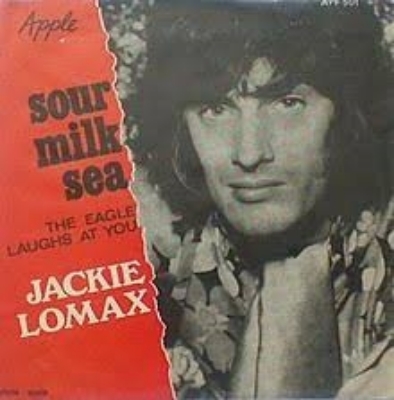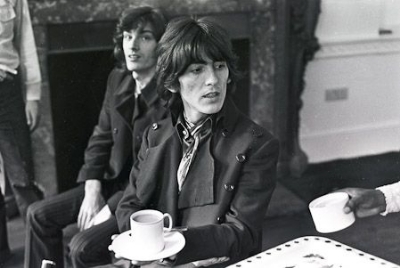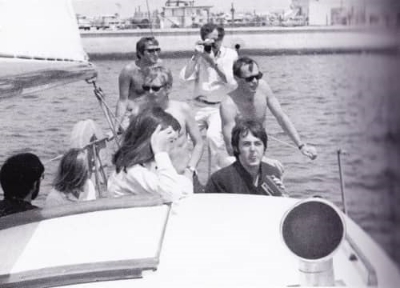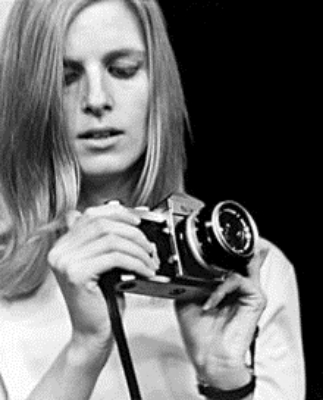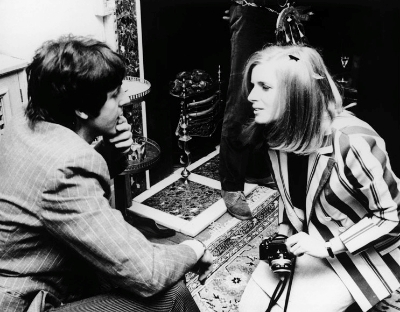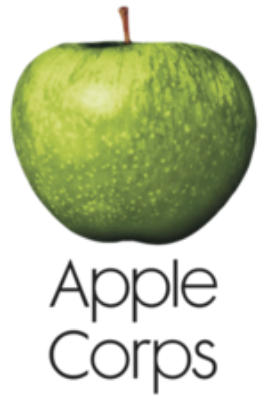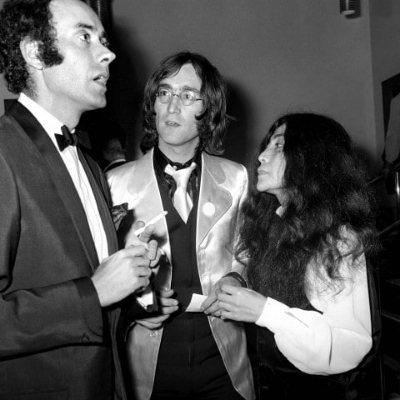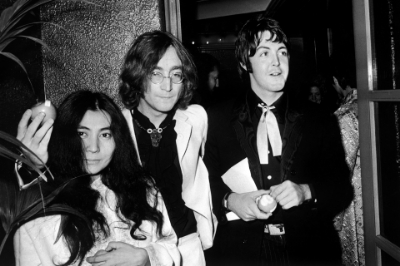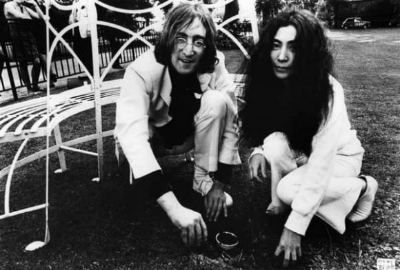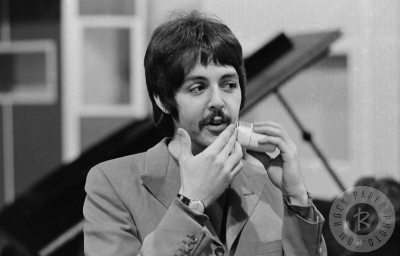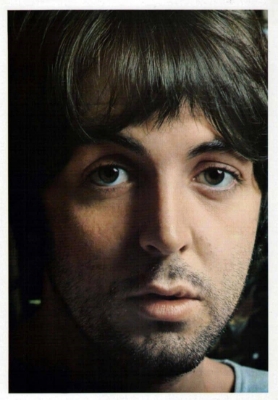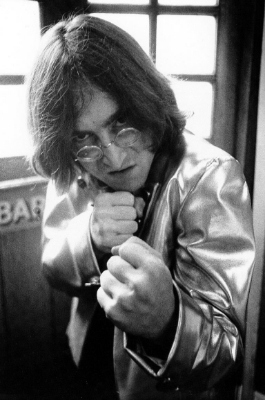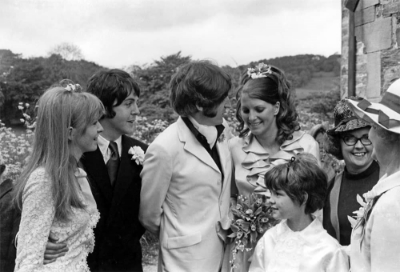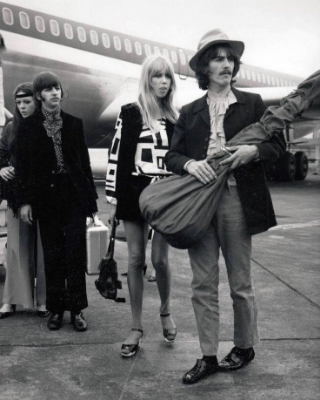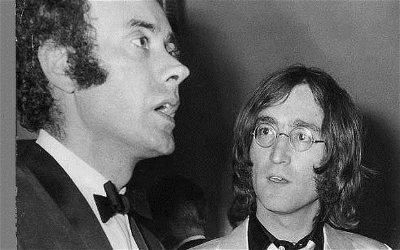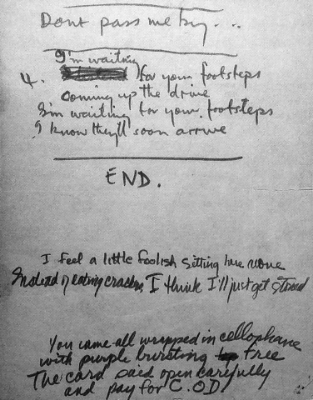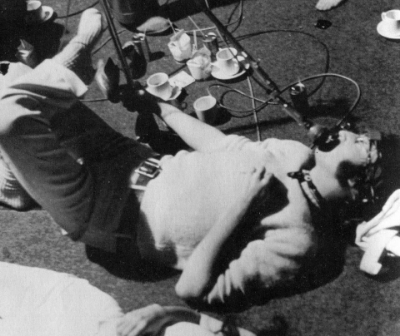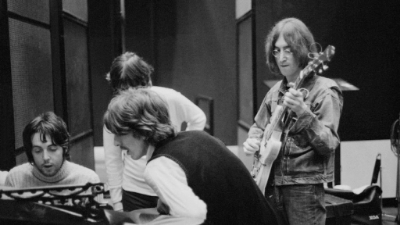The Beatles in-between recording
Fab Four Blog
The Beatles began work on Good Night, the White Album's final track, on this day.
The session began at 7pm and finished at 4.30am the following morning. It began with a number of rehearsals which were committed to tape.
One of the rehearsals was included on 1996's Anthology 3. It features Ringo Starr on vocals, John Lennon playing piano, and George Harrison keeping time on a shaker.
The Beatles recorded five proper takes of Good Night during this session, featuring just Starr's vocals and Lennon's acoustic guitar. Lead and backing vocals were added onto the last of these on 2 July 1968.
The Beatles are in-between recording
George Harrison produced a third session on this day for fellow Liverpudlian musician Jackie Lomax, recording Harrison's song Sour Milk Sea.
The song was recorded at Abbey Road over three days, on 24-26 June 1968, as well as a Lomax song, The Eagle Laughs At You.
Harrison produced the songs and played acoustic guitar, with McCartney on bass, Starr on drums, Eric Clapton on guitar and Nicky Hopkins on piano. The Eagle Laughs At You featured Harrison and Clapton playing rhythm and lead guitar alongside Lomax, but no other Beatles.
For the first two of the days McCartney was out of the country, but added his bass part to Sour Milk Sea on this day. It is likely that the backing track for another Lomax song, You've Got Me Thinking, was also recorded during these sessions. McCartney also busked the song on 21 January 1969 during the Get Back/Let It Be sessions.
Jackie Lomax was the first artist to sign to The Beatles' Apple label. Sour Milk Sea was released as a single in August 1968, with the catalogue number Apple 3. It was part of Apple's "Our first four" set of singles, which also included The Beatles' Hey Jude, Mary Hopkin's Those Were The Days and the Black Dyke Mills Band's Thingumybob.
The song also appeared on Lomax's debut album, Is This What You Want?, released by Apple in March 1969.
George Harrison produces Jackie Lomax’s Sour Milk Sea
George Harrison produced the second session on this day for fellow Liverpudlian musician Jackie Lomax, recording Harrison's song Sour Milk Sea.
The song was recorded at Abbey Road over three days, on 24-26 June 1968, as well as a Lomax song, The Eagle Laughs At You.
Harrison produced the songs and played acoustic guitar, with McCartney on bass, Starr on drums, Eric Clapton on guitar and Nicky Hopkins on piano. The Eagle Laughs At You featured Harrison and Clapton playing rhythm and lead guitar alongside Lomax, but no other Beatles.
For the first two of the days McCartney was out of the country, but added his bass part to Sour Milk Sea on 26 June. It is likely that the backing track for another Lomax song, You've Got Me Thinking, was also recorded during these sessions. McCartney also busked the song on 21 January 1969 during the Get Back/Let It Be sessions.
Jackie Lomax was the first artist to sign to The Beatles' Apple label. Sour Milk Sea was released as a single in August 1968, with the catalogue number Apple 3. It was part of Apple's "Our first four" set of singles, which also included The Beatles' Hey Jude, Mary Hopkin's Those Were The Days and the Black Dyke Mills Band's Thingumybob.
The song also appeared on Lomax's debut album, Is This What You Want?, released by Apple in March 1969.
Paul McCartney sails to Santa Catalina Island, California
On 21 June 1968, Paul McCartney had arrived in Los Angeles with other representatives of Apple Records to promote their label to Capitol Records executives. On this day, however, they had a day off, allowing McCartney to spend time with his new girlfriend Linda Eastman.
In addition to McCartney, the Apple party included label boss Ron Kass and employee Tony Bramwell, as well as McCartney's childhood friend Ivan Vaughan. On this day they were invited to sail on a yacht belonging to Warner Bros executive John Calley.
Paul knew that if Linda went with him on the boat, the news [of their relationship] would get out very quickly. He was torn between going, or keeping her a secret for a little longer by hiding her back in the bungalow. In the end he decided they would both go, and Linda could always say she was just taking pictures.
As we left the hotel to get into the limo, [actress] Peggy Lipton suddenly appeared, bikini and towel packed in her beach bag, ready to spend the day with us. Somebody must have told her we were going sailing. 'Oh my God,' said Paul when he spotted her. 'She can't come.'
I had to tell her in the nicest possible way that it was a private party, while Linda stood quietly to one side pretending she wasn't with us. Peggy was very upset and got very argumentative. I realised that she needed the publicity for her career and had been told to make sure she got it, but Paul was tired of girls who used him. We drove off fast, leaving Peggy standing on the hotel steps in tears.
It was one of those perfect days, though not for Peggy, of course. We sailed to Catalina, feeling like Bogart and Bacall for whom the island was a favourite destination, along with the Flynns and the Fairbanks. We dived off the sides of the sailboat into the clear blue sea where dolphins swam, sunbathed on the decks, ate bacon sandwiches and drank champagne. It was a wonderful day, an antidote to the months of madness in London.
Some brief colour footage of Paul and Linda exists from this time, on the boat and around the pool at the Beverly Hills Hotel. It was shot using a home film camera, and lasts little over 30 seconds.
This was the final day of the Apple promotional trip. In the evening the party flew from Los Angeles to New York, where they caught a connecting flight to London.
Late that afternoon, we checked out of the hotel to return to London. Paul and Linda were like Siamese twins, holding hands and gazing into each other's eyes all the way to the airport. In the VIP lounge, they sat apart from us on a small group of seats in a central aisle, the kind of seats that are back to back with another row. Suddenly, the doors burst open, like the sheriff and his men at the big bad saloon.
'FBI!' one of them barked, flashing a badge. 'There's a bomb warning on your flight. Do you know of any Caucasian male with a grudge against you?'
Paul looked surprised. This was years before stars were assassinated and needed bodyguards. He said, 'No, nobody.'
'Do you mind if we search your baggage?' they asked.
Out of the corner of my eye, I noticed Linda very swiftly aiming a neat little backward kick with her heel. Her square vanity case, which she had placed on the floor beneath her seat, skidded to the row of empty seats and, fortunately, came to rest exactly underneath one of them. Casually, she stood up. 'Well, guys, I guess this is good-bye,' Linda said. 'I'd better check on my flight.'
'What flight are you on?' one of the agents asked.
'New York,' Linda said. I'm not traveling in Mr McCartney's party.' She smiled at us all and sauntered off through the door of the VIP lounge as if she had all the time in the world, and as if there wasn't enough marijuana packed into her vanity case to get a herd of elephants stoned.
We all wondered if Linda had managed to sneak back for her vanity case, or if it remained there. Who knows? I never asked
Paul McCartney and Linda Eastman spend time together in Los Angeles
The day after they fell in love in Los Angeles, Paul McCartney and Linda Eastman spent much of the day together at the Beverly Hills Hotel, where he was staying as part of an Apple promotional trip.
The previous evening they had visited the Whiskey-A-Go-Go club, before returning to the hotel in the small hours.
The next day, evening more fans turned up and mobbed the hotel. Crowds of fans were milling in and around the main entrance, lobby and grounds, while Paul and Linda were still in bed making love. Finally, to thank them all for coming, Paul got up and sat on the steps of the bungalow, playing his guitar and singing to them – I think it was Blackbird
– while Linda kept quietly in the background, not wanting to be seen. (Tony Bramwell - Magical Mystery Tours)
At lunchtime the Apple party – which included McCartney, label boss Ron Kass, and McCartney's childhood friend Ivan Vaughan and Apple employee Tony Bramwell – visited Capitol Records president Alan Livingston at his home in Beverly Hills, before spending the afternoon at the home of Capitol executive Ken Fritz.
On returning to the bungalow, Linda passed around a Victorian cloth drawstring bag stuffed full of grass. In London this bag became her trademark, the legendary 'spice-bag' that [Ronnie] Plonk Lane of the Faces wrote about in a song. All kinds of music people started to drop by, like Roger McGuinn from the Byrds. Boyce and Hart, the songwriters for the Monkees, telephoned to invite us to one of their notorious toga parties, a Hollywood version of a Roman orgy. Paul asked me to turn down all invitations so he could spend time alone with Linda. I did, but a leggy young starlet named Peggy Lipton, who had met Paul during their last America tour and still had designs on him, kept calling all through the night. (Tony Bramwell - Magical Mystery Tours)
Paul McCartney addresses Capitol Records conference
On this day Paul McCartney addressed a sales conference attended by executives from Capitol Records, where he announced that all future Beatles records would be released through the group's Apple Records label.
The conference took place at the Beverly Hills Hilton hotel. McCartney gave a brief address before playing a promotional film which had been made on 11 June.
Paul delivered a short speech to announce that EMI/Capitol would distribute Apple Records and, from now on, The Beatles were on the Apple label. That was a cue for me to show the film. Paul spent time doing the old meet-and-greet and being photographed with top Capitol executives, Alan Livingston, Stanley Gortikov and Ken Fritz. It was a PR masterpiece. (Tony Bramwell)
Magical Mystery Tours
Following the event, McCartney and his companions – Apple's Ron Kass and Tony Bramwell, plus childhood friend Ivan Vaughan – returned to the Beverly Hills Hotel, where they were staying for the duration of their US trip.
Relieved at how well it had gone we were ready to return to the hotel and leap into the swimming pool again. When we went into the bungalow to change, followed by the trail of girls, we were rather surprised to find Linda
[Eastman] sitting there radiantly, totally spaced out, waiting for Paul. She had a joint in one hand and a beatific smile on her face. Paul immediately detached himself from the circus surrounding him and took Linda aside. As I looked across the room, I suddenly saw something happen. Right before my eyes, they fell in love. It was like the thunderbolt that Sicilians speak of, the coup-de-foudre
that the French speak of in hushed tones, that once-in-a-lifetime feeling. Paul was struck almost dumb as he and Linda gazed at each other. (Tony Bramwell, Magical Mystery Tours)
In the evening the party – now including Linda Eastman – went to LA's Whiskey-A-Go-Go, where they watched BB King and the Chicago Transit Authority (later Chicago) perform.
The club was hot, dark and crowded. Paul and Linda sat in a corner both while we acted as a kind of hedge. By a strange coincidence, both Eric Burdon and Georgie Fame were in the booth next to us, a fact not missed by Linda or Paul in their state of heightened awareness. Eric and Georgie had been at the Bag O'Nails on the night they had met some thirteen months ago. Now here they were on the night they had fallen in love. It was a sign.
Tony Bramwell
Magical Mystery Tours
Paul McCartney flies from New York to Los Angeles
The previous day, Paul McCartney had flown from London to New York, for the first stop on a promotional trip for Apple. On this day he arrived at his final destination: Los Angeles, California.
The purpose of the trip was to show a promotional film at the Capitol Convention in Los Angeles, where record company executives would be able to see The Beatles' intentions for their business. He was accompanied on the trip by head of Apple Ron Kass, employee Tony Bramwell and Ivan Vaughan, McCartney's childhood friend who had introduced him to John Lennon on 6 July 1957.
At the luxurious Beverly Hills Hotel we were given a bungalow beside the pool. It seemed like heaven! The first thing we did was change and go for a swim. Cliché as it might be, but, this is the life
, I thought, as Paul and I floated side by side on lilos, drinks in hand and gazing at the blue sky as the heavy scent of jasmine and orange blossom wafted in the air.
That afternoon, we decided to shop on Sunset Strip. To me, everything was wildly expensive, but Paul didn't care.
'Sign for anything you want,' he told me. It was a bizarre situation. Here was a young man worth many millions who didn't have a penny on him. A bit like royalty, I suppose. At any rate, everyone was more than happy to have our signatures.
'Make the bill out to Apple,' Ivan and I said grandly, collapsing into giggles around the corner on Rodeo Drive. It seemed unreal. Even Paul said that after several years he still couldn't get used to this way of life...
On our shopping trip, Paul and I bought Nehru jackets. Paul's was red velvet and mine was white silk. We also bought several pairs of exotic sunglasses with pink lenses at a psychedelic optique, which we clowned around in. One pair would have done, but we couldn't make up our minds which we liked and in the end Paul said, 'To hell with it. Let's have 'em all.' Once again, as we signed the outrageous bill, we found it wildly funny and ran into the street, laughing like people who had done a runner from the Chinese restaurant without paying.
Tony Bramwell
Magical Mystery Tours
In the evening they enjoyed the Los Angeles nightlife, visiting restaurants and clubs.
That night, after another dip in the warm silky water of the swimming pool, we dressed in our new gear, put the psychedelic glasses on, and swanned off in a limo with tinted windows, ten miles long. This was the sixties and in the accepted parameters of cool, we were the coolest of the cool...
As the news that Paul was in town spread like wildfire, the girls began to appear in their droves again. Our first stop was Romanoff's, Frank Sinatra's favourite restaurant, run by a sort of Russian prince. Then we were off clubbing. The Factory was next on the agenda. Located in the middle of a large industrial warehouse, the members were mostly Hollywood elite, people like Paul Newman and Steve McQueen. Paul Wasserman, 'Wasso,' the top Hollywood press agent, sat with us, greeting and introducing, pointing names out. Sammy Davis Jr was there and came over to our table for a chat.
'Hi, Paul, how're you doing, man? Glad to see ya.' I was fascinated by the amount of gold jewelry this very short man could drape on his wiry little body and still dance. Ringo would have been impressed. Ringo loved gold, loved to dance, and he was good at it, too. Meanwhile, models and starlets were throwing themselves at us. If they couldn't grab Paul's attention, then Ron, Ivan or myself would do. The Scotch and Cokes didn't stop flowing until the early hours, all of us on such a natural high that we didn't feel any ill effects. We tipped out of the club, still accompanied by Wasso and several girls. I think I ended up with an air-hostess, but it was hard to tell. Dozens of girls were mobbing around and came back to the hotel with us. Traveling back down Sunset Strip to the hotel with a carload of girls, Wasso took great delight in bumping our car from behind with his equally gigantic Cadillac before he overtook us, waved, and roared off home.
Tony Bramwell
Magical Mystery Tours
Paul McCartney flies to New York
While work continued on the White Album in London, Paul McCartney flew to America on this day for promotional duties for Apple.
The purpose of the trip was to show a promotional film at the Capitol Convention in Los Angeles, where record company executives would be able to see The Beatles' intentions for their business. Initially, however, they flew to New York since a direct flight to LA wasn't available.
He was accompanied on the trip by head of Apple Ron Kass, employee Tony Bramwell and Ivan Vaughan, McCartney's childhood friend who had introduced him to John Lennon on 6 July 1957.
The party flew from London Airport to New York's John F Kennedy International Airport, where McCartney attempted to contact Linda Eastman.
We literally rushed to the airport to get flights and, since we couldn't get a direct flight to LA, had to make a stopover in New York. The first thing Paul did on arrival at Kennedy on June 20, 1968, was to dig out that check with Linda's number on it that, tellingly, he had carefully kept in his wallet, and telephoned her. She was out, so he got her answering service.
'Hey, I'm in America!' he said. 'Come and hang out for a couple of days. I'm staying at the Beverly Hills Hotel.' He seemed disappointed that she hadn't been in to answer the telephone herself.
Tony Bramwell
Magical Mystery Tours
The following day they continued to Los Angeles, returning to England on 25 June 1968.
The night before was the Première of John Lennon's In His Own Write stage play
The National Theatre's stage version of John Lennon's book In His Own Write, directed by Victor Spinetti, had its début at the Old Vic Theatre on London's Waterloo Road.
The play was the idea of dramatist Adrienne Kennedy, who co-wrote it with Spinetti. They based it on Lennon's first book and the follow-up, A Spaniard In The Works. It featured a character, Me, played by Ronald Pickup, whose thoughts and ideas were followed throughout the play.
Lennon's arrival with Yoko Ono caused much fuss among the journalists and reporters present. Although the pair had first appeared in public some weeks earlier, the news of Lennon's marriage ending was still largely unknown.
The press hostility towards Ono can perhaps be traced to this day. Several reporters called out, "Where's your wife, Mr Lennon?" His only reply to them was "I don't know."
During its run at the Old Vic, In HIs Own Write followed two other one-act plays to form a triple bill. The others, neither of which was connected to Lennon, were A Covent Garden Tragedy and An Unwarranted Intrusion.
Also at the play were George and Pattie Harrison, and Ringo Starr and his wife Maureen. Paul McCartney was absent, choosing instead to attend the opening of another play, starring his fiancée Jane Asher.
Paul McCartney celebrates his 26th birthday at Apple
With George Harrison and Ringo Starr flying back from America, and John Lennon preparing for the première of the In His Own Write stage play, Paul McCartney spent his 26th birthday without the other Beatles at the Apple offices in London.
At the time, Apple was situated at 95 Wigmore Street, London. McCartney invited several fans – the legendary Apple Scruffs – inside the building to join him for lunch.
In the evening, while the other Beatles were at the Old Vic watching In His Own Write, McCartney attended the opening of another play starring his fiancée Jane Asher.
The Beatles taking a small break today.
The Beatles are busy recording "Revolution"
John and Yoko plant acorns for peace at Coventry Cathedral
Saturday 15 June 1968 John Lennon, People
In their first public event, John Lennon and Yoko Ono planted acorns for peace at St Michael's Cathedral, Coventry.
John Lennon and Yoko Ono plant acorns for peace, Coventry Cathedral, 15 June 1968
The site they had originally intended to use in the grounds of the cathedral had to be moved after Canon Verney refused to allow the unmarried couple to bury anything in consecrated ground.
Furthermore, the original acorns were quickly stolen by Beatles fans, and replacements sent by Lennon and Ono were placed under 24-hour guard.
The Beatles are in-between recording.
-Paul McCartney is filmed in EMI Studios performing Blackbird for a short film being assembled to promote Apple Records.
The Beatles in-between recording "Revolution"
Recording, mixing: Blackbird, Revolution 9
Recording, mixing: Blackbird, Revolution 9
Tuesday 11 June 1968 Studio
Studios Two and Three, EMI Studios, Abbey Road
Producer: George Martin
Engineer: Geoff Emerick
George Harrison and Ringo Starr were both in America on this day, but John Lennon and Paul McCartney made the most of the studio block-booking throughout June to continue work on the White Album.
A film crew from Apple, directed by Tony Bramwell, was present during the session, ostensibly to make a 10-minute promotional short for the company. Recorded onto 16mm film, the footage captured McCartney working on Blackbird and Helter Skelter on an acoustic guitar, as well as various other scenes from inside the studio, in the Apple Boutique, Apple Tailoring, McCartney's garden and other locations. Other people featured in the promo, which was simply titled Apple, included Lennon, Mary Hopkin, James Taylor, Dick James, Alexis Mardas and NEMS's Alistair Taylor.
Fortunately, the sound recordist also made a 41-minute tape of McCartney rehearsing Blackbird, from which we can see the song take shape. The tape begins with a performance which producer George Martin is timing. Afterwards he tells McCartney that the song is just shy of two minutes and suggests he makes more of the break before the coda. McCartney then plays a half-speed version of the song, which morphs into Cliff Richard's Congratulations.
With Martin in the control room of Studio Two, McCartney attempts a complete run-through. Lennon suggests that the studio lights be dimmed to improve the atmosphere, and Martin suggests that a rough demo would help them decide an arrangement. Lennon, however, says that vocals and guitar are sufficient.
Lennon and Martin begin discussion Revolution 1's lengthy ending, and various recordings made for the stage play of In His Own Write. In the background McCartney plays a version of Helter Skelter in a falsetto voice.
There then follows a brief version of Blackbird featuring both Lennon and McCartney on acoustic guitars, before McCartney continues playing alone, singing in an Elvis style and ad-libbing a talking blues.
With Lennon in the
control room, they discuss the arrangement again. Lennon suggest a brass band, and McCartney plays a version of Mother Nature's Son. A number of versions of Blackbird follow, most of which end with a false start.
After a break, McCartney continues recording, and eventually manages a full take. His fourth attempt from this time was released on 1996's Anthology 3. Thirty-two takes of Blackbird were recorded during this session, just 11 of which were complete.
Take 32 was considered the best, and six mono mixes were made before the session ended at 12.15am. The last mix featured additional bars of guitar at the beginning, which were later omitted. The song was remixed on 13 October 1968, after McCartney realised that Blackbird would sound better with the sound of actual birds on it.
Meanwhile, between 7pm and 10.15pm, John Lennon was in Studio Three working on sound effects for Revolution 9. He spent the next few days working on the track, before a master tape was assembled on 20 June 1968.
Recording: Revolution 9
Monday 10 June 1968 Studio
Studio Three, EMI Studios, Abbey Road
Producer: George Martin
Engineer: Geoff Emerick
John Lennon spent this session, which took place from 2.30-5.45pm, assembling sound effects for Revolution 9.
Lennon spent the next few days working on effects and tape loops, which were mostly assembled into a master reel on 20 June 1968. For this he worked largely just in the company of his girlfriend Yoko Ono, although he was joined on the 20th by George Harrison.
Recording "Revolution" in the studio
Paul McCartney is best man at his brother Michael’s wedding
Paul McCartney was the best man at his brother Michael's wedding on this day.
Mike McCartney married Angela Fishwick, a hair stylist, at St Bridget's Parish Church in the small village of Carrog in Merionethshire, north Wales. It was the same church where the McCartneys' father Jim had married his second wife in 1966.
The other Beatles sent congratulatory telegrams. George Harrison and Ringo Starr were both in California, while John Lennon remained in London.
The wedding reception was held at Jim McCartney's home in Gayton, Cheshire. Paul led a singalong around the family piano.
George Harrison and Ringo Starr fly to America
George and Pattie Harrison, Ringo Starr, Maureen Starkey and Mal Evans all flew to California on this day.
The purpose of the visit was for Harrison to make a guest appearance in Ravi Shankar's film Raga. The scene was filmed on 10 and 11 June in the Big Sur area of San Francisco, but the party stayed in Monterey during their visit.
The film was originally made under the working title East Meets West, and later known as Messenger Out Of The East before the eventual title was settled upon.
The party remained in America until until 18 June; in their absence John Lennon and Paul McCartney continued work on the White Album.
BBC interview with John Lennon and Victor Spinetti
While Paul McCartney and Ringo Starr were elsewhere in the studio working on the White Album, John Lennon gave an interview to the BBC about the stage adaptation of his book In His Own Write.
Also present was Victor Spinetti, the play's director and co-writer. The interview was recorded in EMI Studios on London's Abbey Road, and was for the BBC 2 arts show Release. It was first broadcast at 10.05pm on Saturday 22 June.
The interview was conducted by Peter Lewis. It was edited into four parts, and was used between extracts from the stage play filmed in a BBC studio on 21 June.
At the end of the recording session, which finished at 2.45am, Lennon recorded 12 sound effects tapes to be used in In His Own Write. The play opened at the Old Vic Theatre on 18 June.
Peter Lewis: A Beatle at the National theatre, an excerpt from In His Own Write, John Lennon – the writer, and Victor Spinetti – who adapted and directed it. It opened last Tuesday, the critics in general thought it worth trying, even if it didn't altogether work. Among the expectant audience, Lennon readers were delighted, non-readers probably sat there 'astoundaghast'. Sir Lawrence Olivier, director of the National theatre, took a gamble on the play for their triple bill.
It came from Lennon's books, In His Own Write and A Spaniard In The Works, which came out three years ago. They are collections of stories and poems peppered with imaginative and irreverent distortions of the worlds, phrases and names that are part of our everyday reading, listening and viewing, "BBC Panarathma", "Shamrock Womlbs" and "Jack The Nipple" alias Jack The Ripper, there's satire and melancholy and Lennon's eccentric drawings. The play weaves the verse and the prose into a picture of a boy growing up. On one side it's shows his tele fixated family, the human vegetables, on the other the dreams and the fantasies he uses to escape from them. It's like looking at the clichés of post-war Britain in a hall of mirrors provided by Lennon's warped language, this was the achievement of director Victor Spinettti.
John Lennon: When I saw the rehearsal of it, I got quite emotional, as if I'd written it [the adaptation]. I mean, I knew, in my heart of hearts, who was who and what the book was saying, but not enough, I was too involved with it when it was written, and any criticism it had – was either just 'Rubbish' or still only writing about what was on the paper. So it took something like this to happen to make me see what I was about then.
Victor Spinetti: What was interesting about it to me was, the play was brought to me to act in, you see, and when I read it I began to feel, by reading the poems and the stories, the kind of things that happened to me as a kid, and the kind of things I heard, and thank god it corresponded with when John perceived the kind of things that influenced him.
And the most important line in it is really – the influences about us, the things that make us what we are, make you what you are now, or make us what we were, the things that we half heard, you know, as kids.
Peter Lewis: Well an awful lot of the play is about radio and TV.
John Lennon: Well I mean that's all I ever heard, didn't I, I mean you go home...
Victor Spinetti: Comic books, you got the church...
John Lennon: You got yer comic books, yer classic comics, yer Beanos...
Victor Spinetti: Yer school...
John Lennon: Aye, yer school, yer pub and yer TV and yer radio and that was it.
Peter Lewis: Exactly. Funny thing you didn't put in pop music.
John Lennon: No because up 'till then it hadn't hit me. Pop music didn't hit me until I was 16 and this is all before, the things that happened before 16.
Victor Spinetti: But it's not really John's childhood, it's all of ours really, isn't it John?
John Lennon: It is, we're all one Victor, we're all one aren't we? I mean, what's going on?
Peter Lewis: There's another thing about this boy and that is: he won't talk plain English. He invents his own language. Which is what you did when your books started coming out.
John Lennon: Well yeah, that was just a hangover from school. I used to make the lads laugh, with that scene, talking like that, and writing poetry. I used to write them and just give them to friends to laugh at, and that was the end of it. So when they all go down in a book, when it turns into a book or a play etc etc. It's just my style of humour.
Peter Lewis: Instead of saying, for example as I was going to, say "forsample".
Victor Spinetti: "Forsample!" Yes, and "He was astoundaghast!"
John Lennon: Well, some of them 'cause I was never any good at spelling, all me life, I never quite got the idea of spelling. English and writing, fine, but actually spelling the words. And also, I typed a lot of the book, and I can only do it very slowly with a finger, so the stories would be very short 'cause I couldn't be bothered going on. And also I'd spell it as you say it like Latin really, or just try and do it the simplest way to get it over with, 'cause all I'm trying to do is tell a story, and what the words is spelt like is irrelevant really. But if they make you laugh because the word used to be spelt like that, that's great. But the thing is – the story and the sound of the word.
Peter Lewis: A lot of people wrote about your book and said "Oh James Joyce, Edward Lear" and so on, what did you think when they said that?
John Lennon: Well, when they said James Joyce I hadn't, I must have come across him at school but we hadn't done him like I remember doing Shakespeare and I remember doing so and so. I remember doing Chaucer a bit, or somebody like him doing funny words, but I don't remember Joyce. The first thing they say "Oh he's read James Joyce," so I hadn't, so the first thing I do is buy Finnegans Wake and read a chapter and it's great and I dug it and I felt like – here's an old friend, but I couldn't make right through the book, and so I read a chapter of Finnegans Wake and that was the end of it, so now I know what they're talking about. But he just went, he just didn't stop, yeah.
Peter Lewis: What actually though, had you read – that you know was important to you when you were young?
John Lennon: Only kids books, Alice In Wonderland. The poems are all from Jabberwocky, started me into that kick. And drawing I started trying to draw like Ronald Searle when I was about Eight. So there was Jabberwocky and Ronald Searle I was turning into by the time I was Thirteen. I was determined to be Lewis Carol with a hint of Ronald Searle.
Peter Lewis: Were you a Sherlock Holmes reader?
John Lennon: No. I had a holiday after we first made it big as Beatles in Tahiti, and there was nothing on the boat but books. And Tahiti and all those Islands, great, but I still got into reading, so I was writing Spaniard In The Works and I knew, I never got past a story longer than a page, so I read a whole stack, sort of 'The Madman's Sherlock Holmes' where you get all the stories in one and I realised that every story was the same story, so I just wrote one Shamrock Womlbs after Three weeks of Sherlock Holmes in Tahiti. And that was the end of it.
Peter Lewis: There's a very very sad poem at the end of the play about Kakky Hargreaves who is some sort of person who's name changes during the poem who's gone, lost. Who was Kakky Hargreaves?
John Lennon: Nobody was Kakky or Kathy or Tammy, so it was all those people. But the point is that you got it, the sadness that I wrote into it, but after I'd written it, you write something, a song or anything, you get the sadness and then you perform it or you put it on paper and then that's gone and the only way you get the joy back of writing it or the sadness back, is when somebody like Victor or somebody else comes and reads it to you or acts it out, like when I first saw the rehearsal of the play, and they said these words back to me and I got the sadness from Kakky Hargreaves like I'd never heard it before.
Peter Lewis: You wrote that one when you were very young.
John Lennon: Yes. That was sort of pre-Beatle, 18, 19.
Peter Lewis: And have you written lately?
John Lennon: Well I write, I think all the time, so it's the same, I don't put it on paper so much these days, but I mean it goes into songs, a lot of the same energy that went into those poems. I don't know what I actually do with the thoughts but they come out either on film or on paper or on tape. I've just got lots of tape which I suppose if I put onto paper it'd be a book. But it's just a matter of – do I want to make those tapes into paper or make the tapes into records.
Peter Lewis: Does it feel the same to you when you're writing something on paper and when you're writing a song lyric?
John Lennon: Er, it does now. In the old days I used to think song writing was this and you know, "I love you" and "You love me" and my writing was something else, you know. Even if I didn't think of it quite like that. But then I just realised through Dylan and other people, Bob Dylan – not Thomas, that it is the same thing. That's what I didn't realise, being so naive, you know, that you don't write pop songs and then you do that and then you do that. Everything you do is the same thing, so do it the same way.
But sometimes I'll write lyrics to a song first and then I'll get the same feeling as Kakky Hargreaves or a poem and then write the music to it after. So then it's a poem sung, sometimes the tune comes and then you just put suitable words to fit the tune, if the tune's doo der loo der loo der la and then you have shagga boo choo cha – you know, you have sound words then, just the sound of it, 'cause it is all sound, everything's vibrations I believe, you know, everything is sound really, or vision. And just the difference between sound and vision I'm not quite sure about. But it's all just 'vurururururururururu...'
Peter Lewis: You live in a 'vurururururururu...''
John Lennon: Yes, I'm just aware that is going on all the time, like that camera is purring and those people are humming over there and you're breathing and inhaling and he's humming and I'm talking on a mmm mmm, so all the time this – is – going – on – like – this – all – the – time. And so I'm aware of that, really.
Peter Lewis: The boy [in the play] hates a lot of things and in a way, you could say you were attacking these things, like organized religion, and the way people teach you in school.
John Lennon: I feel the same now, really, about organized religion, education and all those things that everybody is still laughing at. But I mean, I expressed it that way then. I don't know how I'd express it now, you know. It'd be slightly different really.
Victor Spinetti: But there's a tremendous amount of compassion in his writing, which I love. It really is saying 'Come on, do what you want to do'.
John Lennon: Because, I mean, I've always sort of suspected that there was a God, even when I thought I was an atheist... (Whispers) Just in case..... But I believe it, so I am full of compassion really, you can still, sort of, just dislike things. I just hate things less strenuously than I did. I haven't got as big of a chip about it, because maybe I've escaped out of it a bit. I think our society is run by insane people for insane objectives. And I think that's what I sussed when I was 16 and 12, way down the line. But I expressed it differently all through my life.
It's the same thing I'm expressing all the time. But now I can put it into that sentence that I think we're being run by maniacs for maniacal ends, you know. If anybody can put on paper what our government, and the American government, and the Russian, Chinese... what they are actually trying to do, and what they think they're doing, I'd be very pleased to know what they think they're doing. I think they're all insane. But I am liable to be put away as insane for expressing that, you know. That's what is insane about it. I mean, don't you agree?
Peter Lewis: I do, actually.
John Lennon: It's not just a bit strange. It's just insane, and nobody knows, all these people in the street and half the people watching this are going to be saying, 'What's he saying! What's he saying!' You know. You are being run by people who are insane, and you don't know.
Victor Spinetti: The real world was so insane, the fantasy world becomes something much better. We are living in insane times, aren't we. We really are.
Peter Lewis: Yeah. And the thing that you feel, all the way through, is that, there's this boy trying to get out.
John Lennon: Well, I did, you see. I got out. But that's just a sort of picture of somebody who is still in it. I mean, you get out in your mind.
Peter Lewis: Yeah, all the time he is dreaming his way out.
John Lennon: But I mean, you do, until you actually physically get out of it.
Peter Lewis: Dream your way out into being Sherlock Holmes or...
John Lennon: Whatever.
Victor Spinetti: Whatever. And when the boy leaves at the end, I don't see him going into reality, his reality is his closely knit family locked up in television, he's going into fantasy which I think is a real world.
Peter Lewis: At the end of the play, there's this big family group, and there's a great big family row.
John Lennon: Is there?
Victor Spinetti: Yes, 'Brummer Striving'.
John Lennon: Oh, Brummer Striving!
Peter Lewis: It's all about Brummer Striving, do tell us about Brummer Striving.
John Lennon: Brummer Striving is Brummer Striving, all those jobs that people have that they don't want, and there's probably about 90% Brummer Strivers watching in at the moment. But you don't have to be a Brummer Striver, you see. It depends how involved in Brummer Striving you are, but Brummer Striving... Paul explained it at the beginning of the book, is, errr, it doesn't... What does he say he was saying? – 'What is Brummer Striving?' It isn't anything.
Victor Spinetti: It's grafting, it's doing a job. It is any kind of job you have to graft at, like going to a steelworks, or to a coal man to follow your father.
John Lennon: The universal sorrow just hits you once about a week, now – Bang – And they you say, 'Oh, oh well', and then you're back to 'Well, get on with it', you know, 'Get on with it'.
Peter Lewis: And laugh.
John Lennon: Well, I mean there are laughs to compensate, 'cause if there weren't it'd be very melancholy.
Recording: Don’t Pass Me By
Studio Three, EMI Studios, Abbey Road
Producer: George Martin
Engineer: Geoff Emerick
The second song to be recorded for the White Album was Ringo Starr's first published composition, Don't Pass Me By.
It was initially taped as Ringo's Tune (Untitled), although by the next day it had been given another working title, This Is Some Friendly. This, despite it having been mentioned as far back as 1963 that Starr was working on a song titled Don't Pass My By, which Paul McCartney even sang a snippet of in a radio interview.
The Beatles recorded three takes of the backing track on this day, with McCartney on piano and Starr on drums. At the end of the third attempt McCartney exclaimed "I think that's got it!", followed by Starr's call to the control room, "I think we've got something there, George!"
More drums, a sleigh bell and a cowbell were then overdubbed onto take three. McCartney also double-tracked his first piano part, this time feeding the sound through a Leslie rotating speaker.
With all four tracks of the tape now full, a reduction mix was called for. This was done in two attempts (takes four and five), the second of which was judged to be better. Starr then overdubbed his first attempt at a lead vocal, with the machine running slightly slower – 46 cycles per second rather than the usual 50 – to raise the pitch and tempo upon playback.
McCartney recorded two separate bass guitar parts, one of which erased Starr's vocals. The session ended at 1.30am, but not before another reduction mix – take six – was made. This was later ignored, however, and work continued on the following day with more overdubs added to take five.
Recording, mixing: Revolution 1
Studio Three, EMI Studios, Abbey Road
Producer: George Martin
Engineer: Geoff Emerick
The third session for Revolution 1 featured vocal overdubs and the creation of tape loops, marking the beginning of the sound collage Revolution 9.
John Lennon decided to re-record his lead vocals at the beginning of the session, which lasted from 2.30pm-1am. This was no ordinary overdub, however: it featured Lennon lying on his back in an attempt to alter the sound of his voice.
John decided he would feel more comfortable on the floor so I had to rig up a microphone which would be suspended on a boom above his mouth. It struck me as somewhat odd, a little eccentric, but they were always looking for a different sound; something new.
Among Lennon's changes in this session was a re-recording of the line "Don't you know that you can count me out... in", making it more equivocal than it previously had been.
Paul McCartney, his new girlfriend Francie Schwartz, and George Harrison recorded more backing vocals, including the words "Mama, Dada" over and over towards the end of the song, although the song was eventually faded out before these latter parts appeared.
Ringo Starr added another drum track, Lennon played a guitar part using a tone pedal, and McCartney recorded an organ overdub. Two tape loops were also made: one of all four Beatles singing a high-pitched "Aaah", and another of a high-pitched guitar note.
The session ended with a rough mono mix being created for Lennon to take away. This has since appeared on bootleg Beatles releases, and is a fascinating document of the song as it began to take on a second life as Revolution 9.
The Beatles recording "Revolution".
The Beatles working on "Revolution"
The Beatles busy recording Revolution.
Recording: Revolution 1
The second session for the White Album saw work continue on Revolution 1, which at this time was known simply as Revolution.
The session began at 2.30pm and ended at midnight. John Lennon double-tracked his lead vocals and Paul McCartney added a bass guitar part.
A reduction mix was then made, known as take 19, which allowed for further overdubs to be made. Backing vocals by McCartney, his new girlfriend Francie Schwartz and George Harrison were then recorded, with the trio singing "shoo-be-doo-wop" during the chorus.
- 1970
- 1969
- 1968
- 1967
- 1966
- 1965
- 1964
- 1963
- 1962

